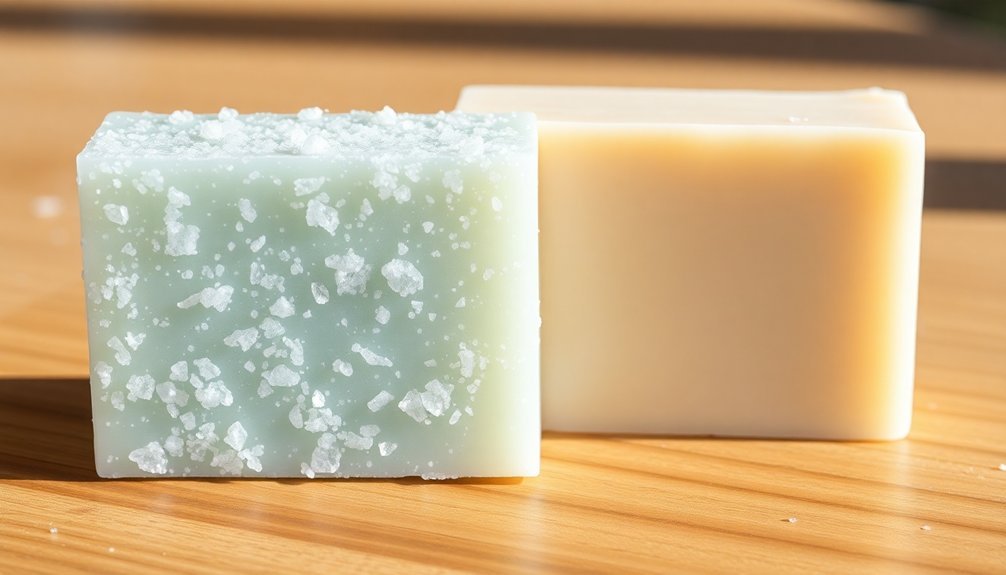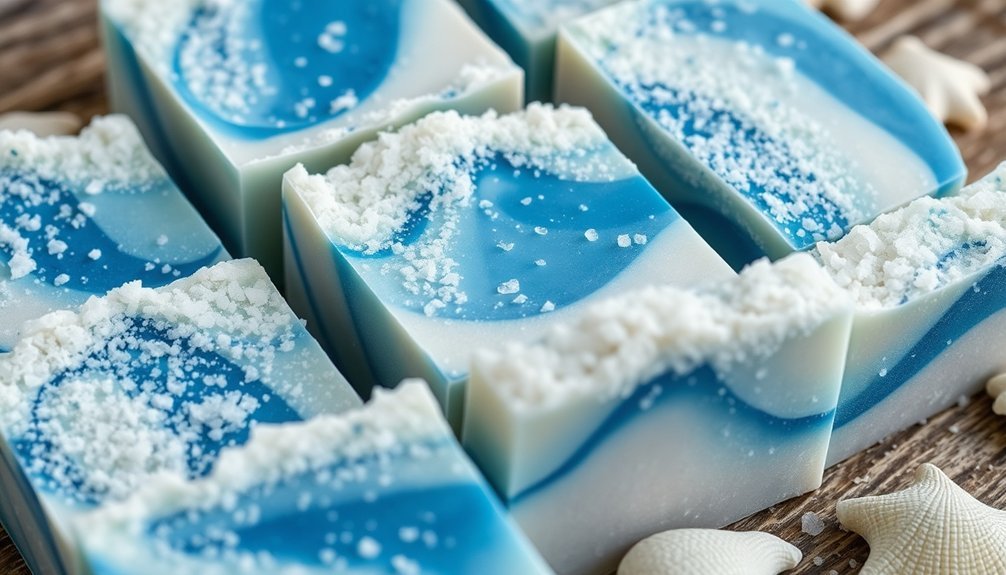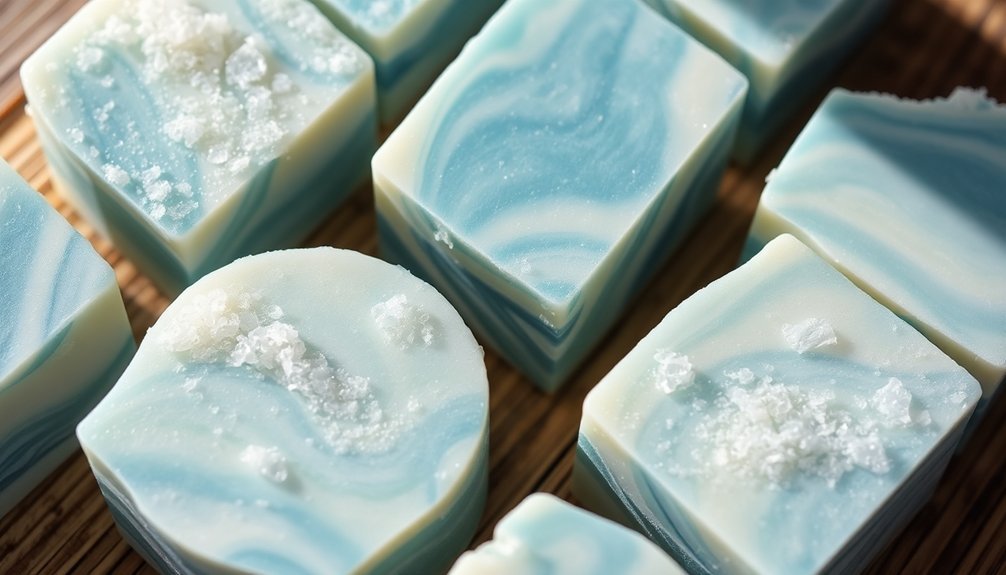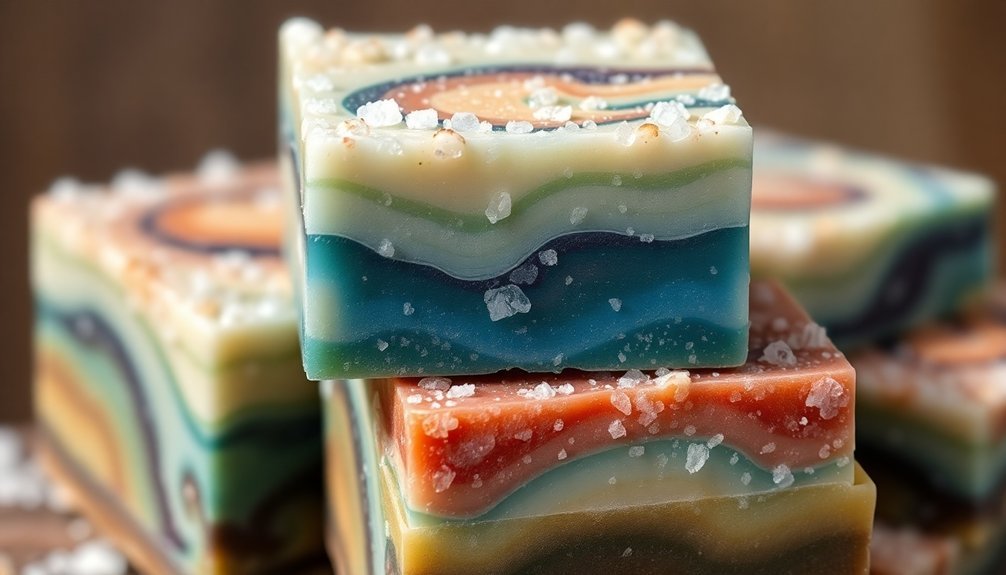Mineral-rich sea salt soaps offer powerful exfoliation while delivering essential nutrients to your skin. Choose coarse salt for oily areas and fine salt for sensitive zones. Top options include Mediterranean varieties (rich in magnesium and calcium), Dead Sea salt bars (excellent for inflammatory conditions), and handcrafted cold-process soaps with high coconut oil content. Look for properly cured bars with 2:1 oil-to-salt ratios for maximum benefits. The right salt soap can transform your skincare routine beyond mere cleansing.
Coarse vs. Fine Sea Salt: Choosing the Right Grain for Your Skin Type

The choice between coarse and fine sea salt in your skincare routine isn't just about texture—it's a decision that directly impacts your skin's health and appearance. Your skin type should guide this selection.
If you have oily skin, coarse sea salt offers stronger exfoliation that helps balance oil production while drawing out impurities from your pores. Its robust texture makes it ideal for salt scrubs that tackle stubborn dead skin cells.
For sensitive or dry skin, fine sea salt provides gentler exfoliation with less risk of irritation. It's also the preferred option for soapmaking, dissolving consistently while still delivering essential minerals like magnesium and calcium.
Those with combination skin might benefit from both: use coarse salt for oilier areas and fine salt for sensitive zones. The mineral composition of sea salt, particularly trace mineral content, helps nourish your skin while providing the mechanical benefits of exfoliation.
Handcrafted Dead Sea Salt Bars With Essential Oil Infusions
Moving beyond grain selection, let's examine nature's most mineral-rich salt option for skincare.
Handcrafted Dead Sea salt bars deliver concentrated magnesium, potassium, and sodium that maintain your skin's moisture barrier while drawing out impurities.
Mineral-rich Dead Sea salt nourishes while it cleanses, fortifying your skin's natural defenses with every use.
When infused with essential oils, these bars transform into customizable therapeutic treatments. You'll benefit from both the salt's natural exfoliation and the targeted properties of selected oils.
These artisanal soaps effectively address specific skin conditions like psoriasis and eczema through their anti-inflammatory properties. The healing power comes from over 26 minerals that are known to improve skin texture and balance oil production.
They're typically formulated with nourishing natural oils like olive or almond that complement the salt's mineral content.
Many producers create these bars using eco-friendly practices and minimal packaging, offering vegan and cruelty-free options.
For maximum therapeutic benefit, look for bars that balance exfoliation with soothing properties suited to your skin type.
Cold-Process Sea Salt Soap Making: Preserving Mineral Benefits

Cold-process sea salt soap making requires careful monitoring of oil saponification to maintain the integrity of skin-nourishing minerals.
You'll need to keep temperatures below 90°F throughout the process to prevent overheating that can cause cracking and mineral degradation.
Maintaining the proper balance of ingredients—particularly a 2:1 oil to salt ratio—ensures your soap retains maximum therapeutic benefits while still producing a satisfying lather. Using high coconut oil content with a 20% super fat creates a mild, creamy bar that won't dry out the skin despite the salt's natural properties.
Oil Saponification Process
When creating mineral-rich sea salt soaps, understanding the saponification process becomes essential for preserving the therapeutic benefits of your ingredients. This chemical reaction occurs when you combine sodium hydroxide (lye) with your chosen oils, transforming them into soap.
You'll need a digital scale for precise measurements—accuracy is non-negotiable when working with lye. Always wear protective gear like gloves and goggles during this stage.
For sea salt soaps, coconut oil often comprises up to 70% of your oil blend, counteracting salt's tendency to reduce lather. Consider adding olive and castor oils for moisture and stable foam. For recipes with such high coconut oil content, use a 15% superfat level to prevent excessive dryness on the skin.
Using sea salt or brine in your lye solution enhances soap hardening while preserving the beneficial minerals like magnesium and calcium that nourish your skin.
Temperature Control Tips
Temperature control stands as a cornerstone of successful cold-process sea salt soap making, directly impacting both the mineral benefits and overall quality of your final product.
For sea salt soaps, aim for cooler temperatures between 100-110°F rather than the standard 120-130°F range. These lower temperatures prevent acceleration, preserve the salt's valuable minerals, and help you avoid gel phase and glycerin rivers.
Prepare your lye solution in advance to allow proper cooling before combining with oils. Keep thermometers handy to monitor temperatures consistently throughout your process. Timing lye preparation 1-3 hours beforehand ensures optimal temperature for combining with your oils while maintaining mineral integrity.
During summer months or in humid environments, you'll need to be especially vigilant about maintaining cooler temperatures.
Consider using ice baths for quick cooling when necessary, and properly insulate your molds to control temperature during curing. This careful approach guarantees your sea salt soap retains its therapeutic properties.
Ingredient Balance Matters
Creating effective sea salt soap requires a delicate balance of ingredients that preserves the salt's mineral benefits while producing a usable bar.
You'll need to use 70-100% coconut oil to maintain adequate lather, as salt typically reduces bubbling and creates a denser, creamier lather instead.
Balance this high coconut content with a generous 20% superfat level to prevent the drying effects that coconut oil can cause.
Add your sea salt after reaching trace, ensuring even distribution without accelerating the process too quickly.
Choose pure sea salt without additives, which retains beneficial minerals like magnesium, calcium, and potassium that nourish your skin.
For enhanced moisturizing properties, consider blending in olive oil, argan oil, or shea butter alongside your coconut base.
This combination delivers both cleansing power and skin-loving benefits.
The recipe recommends using approximately 15 oz. of salt for about 3 pounds of soap to achieve the optimal texture and mineral content.
The Art of Curing Sea Salt Soaps for Maximum Effectiveness

You'll need to cure your sea salt soaps for 4-6 weeks in a well-ventilated space to achieve ideal hardness and mineral retention.
Temperature greatly impacts this process, with cooler conditions typically slowing down curing while warmer environments accelerate water loss.
Maintaining consistent temperatures between 65-75°F will help your soap develop its crystalline structure evenly, ensuring the therapeutic minerals from the sea salt fully integrate into your final product. The longer curing periods significantly improve the quality and performance of soaps with high olive oil content.
Curing Time Guidelines
While the alchemy of soap making ends with the pour, the art of creating exceptional sea salt soap truly begins with proper curing.
For sea salt soaps, you'll typically need 4-6 weeks of curing time, though salt content can accelerate this process.
You'll know your soap is ready when moisture content drops below 9%. Monitor this by regularly weighing your bars—they should stop losing weight when properly cured.
Space your bars to allow air circulation, and control humidity for faster results. These mineral-rich bars need proper exposure to air to develop their skin-healing properties. Choose individual cavity molds for easier handling during the curing phase.
Though saponification completes within 48 hours, the extended curing period develops the crystalline structure that enhances lather, durability, and skin benefits.
When properly cured, your sea salt soap can last up to two years.
Temperature's Critical Role
Temperature stands at the heart of successful sea salt soap making, influencing everything from initial mixing to final curing.
When creating your mineral-rich bars, maintaining proper heat levels guarantees ideal saponification while preserving the therapeutic qualities of your ingredients.
For best results with sea salt soaps:
- Keep your lye solution and oils in the 120-130°F range for ideal mixing conditions
- Lower temperatures generally yield harder bars – beneficial for salt soaps that naturally harden quickly
- Avoid direct sunlight and high humidity during curing to prevent "sweating" and moisture problems
- Consider room temperature when timing your process – hot environments can accelerate reactions, potentially affecting your design intentions
Our premium soap combines sea salt and coconut oil to provide both exfoliation and deep hydration for healthy skin.
Remember that cooler conditions typically work better for sea salt formulations, helping to prevent acceleration while maintaining the skin-nourishing properties.
Mediterranean Sea Salt Varieties and Their Unique Skin Benefits
Within the diverse world of natural skincare ingredients, Mediterranean sea salts stand out for their exceptional mineral profiles and therapeutic benefits. Unlike Himalayan salt (which isn't actually sea salt), Mediterranean varieties are harvested directly from seawater, appearing white and coarse in texture.
What makes these salts valuable for your skin is their rich mineral composition. They're packed with magnesium that soothes inflammation and conditions like eczema, potassium that balances hydration and reduces puffiness, plus calcium and zinc that strengthen your skin barrier. These salts effectively contribute to the balancing of skin pH, creating a protective barrier against environmental aggressors.
When used in soaps, these minerals work together to exfoliate dead cells, lock in moisture, draw out impurities, and improve your skin's elasticity and tone. The balanced mineral content makes Mediterranean sea salt suitable for most skin types, including sensitive skin.
Layering Techniques: How Multi-Mineral Salt Bars Are Created

The artistry behind multi-mineral salt soaps extends beyond ingredient selection to the fascinating world of layering techniques.
You'll find these multi-layered bars offer both aesthetic appeal and targeted therapeutic benefits for your skin through carefully combined minerals.
To create these distinctive soaps, crafters employ several key techniques:
- Temperature control – Maintaining precise oil and lye temperatures guarantees proper consistency between layers.
- Mineral variation – Incorporating salts of different densities creates unique textures for gentle to intensive exfoliation.
- Color differentiation – Using natural colorants like mica or oxides distinguishes each mineral-rich layer.
- Fragrance zoning – Adding different essential oils to each layer creates an evolving scent experience as you use the soap.
With high coconut oil content guaranteeing ample lather, these soaps require longer curing times but deliver exceptional multi-benefit skincare. The proper trace must be achieved with an immersion blender before adding additional ingredients like salt and colorants to each layer.
From Ocean to Soap: The Journey of Sustainably Harvested Sea Salt
As ocean waves crash against shorelines worldwide, an ancient and remarkable process begins—one that transforms seawater into the mineral-rich salt that's eventually incorporated into your luxurious soap bars.
This journey embraces sustainability, relying primarily on sun and wind for evaporation. The process can take years as seawater gradually concentrates in shallow ponds. Technicians continuously monitor salinity levels until crystals form, ready for gentle mechanical harvesting. These shallow ponds create important wetland habitats for diverse species including flamingos.
What makes sea salt special for your skin is its mineral composition—zinc, potassium, and magnesium remain intact, unlike in refined table salt. These minerals provide natural exfoliation, hydration, and anti-inflammatory benefits when used in soap.
Sustainable producers also prioritize biodiversity conservation and proper waste management, ensuring the salt's journey from ocean to soap bar respects both the environment and your skin's needs.
Frequently Asked Questions
Can Sea Salt Soaps Be Used Daily on All Skin Types?
No, you shouldn't use sea salt soaps daily on all skin types. Normal to oily skin can handle 2-3 times weekly, while sensitive or dry skin should limit use to once weekly to prevent irritation.
How Long Do Mineral-Rich Sea Salt Soaps Typically Last?
Your sea salt soap will typically last 4-6 weeks with daily use. It's longer-lasting than regular soap due to its hardness, low water absorption, and natural preservative qualities. Store it properly for maximum longevity.
Do Sea Salt Soaps Help With Specific Skin Conditions Like Psoriasis?
Yes, sea salt soaps can help with psoriasis by reducing inflammation and soothing irritated skin. They'll gently exfoliate scales and the mineral content, especially in Dead Sea salt, provides significant symptom relief for you.
Are Sea Salt Soaps Safe for Use on Facial Skin?
Yes, sea salt soaps are typically safe for your facial skin. They offer gentle exfoliation, contain nourishing minerals, and can help with conditions like eczema. Always patch-test first if you have sensitive skin.
Can Pregnant Women Safely Use Sea Salt Soaps?
Yes, you can generally use sea salt soaps during pregnancy, but choose ones with pregnancy-safe ingredients. They're beneficial for exfoliation and relaxation, but always consult your healthcare provider for personalized advice.
In Summary
You've now discovered how sea salt soaps can transform your skincare routine with their mineral-rich properties. Whether you've chosen a coarse grain for exfoliation or fine salt for sensitive skin, you'll enjoy the benefits of these ocean-derived treasures. Don't hesitate to experiment with different varieties—from Dead Sea to Mediterranean blends. Your skin will thank you for embracing these natural, sustainably harvested bars in your daily regimen.





Leave a Reply